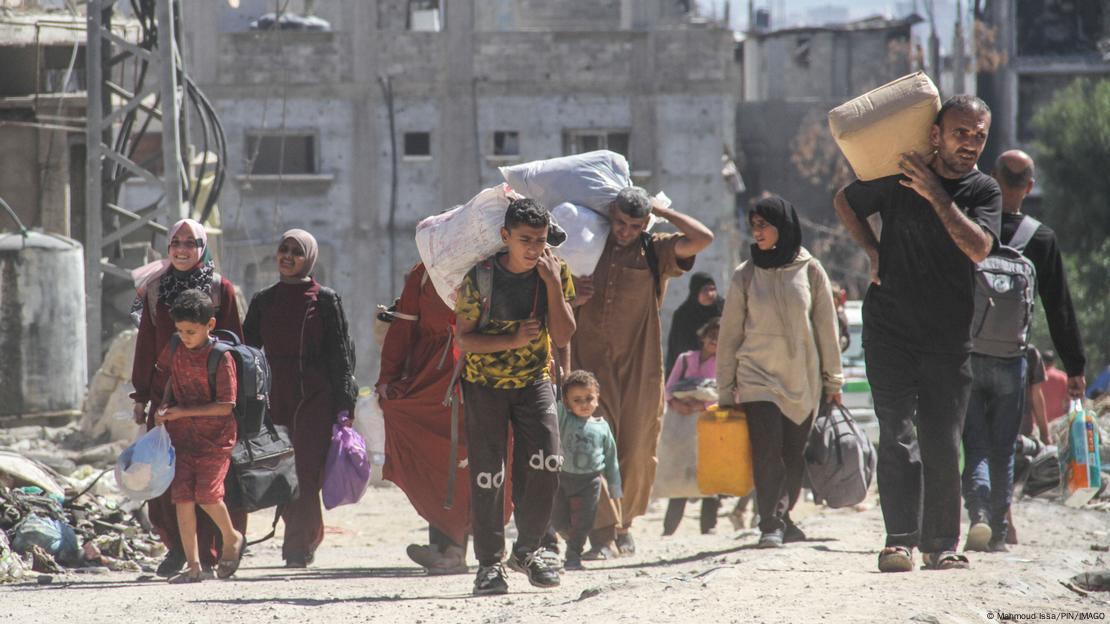
With Israel-Hamas ceasefire elusive, Gaza ‘feels like hell’
For the past 14 months, Zahra’s family has sought safety by moving from place to place in Jabalia and Beit Lahia in the northern Gaza Strip. In December, the family of seven made their way to Gaza City.
“The war has been harsh since day one, but now it feels like hell,” Zahra, who asked that her full name not be used, told DW over the phone from Gaza City, where her family has found shelter in a partially bombed-out house in the Shati refugee camp. “We don’t know if we’ll survive or perish before it ends.”
Despite repeated orders from the Israel Defense Forces (IDF) to head to the southern part of the Gaza Strip, Zahra’s family decided to stay in the north, partly out of fear that they would never be able to return home.
“We didn’t leave the north earlier because we knew the bombardment was everywhere and we hoped the military operation in the north would end soon. But, instead, it became even more unbearable,” Zahra said. “Our house in Jabalia camp was completely destroyed months ago, and now we find ourselves in a state of constant displacement.”
Even as international agencies and governments are pushing for Israel and Hamas to agree to a ceasefire that would lead to the release of the remaining hostages held in Gaza in return for an end to the war and humanitarian relief for civilians, the conflict shows no signs of letting up. Over the weekend, the IDF said it had struck more than 100 targets across the Gaza Strip after Hamas fired rockets into Israel during the past week.
‘No sanitation, nothing’
Across the territory, cold and rainy winter weather is flooding tents and other makeshift homes. Not enough aid is getting through to people, humanitarian organizations have repeatedly warned in recent weeks, in part because of Israel’s blocking of aid, and in part because of looting.
On Sunday, civil defense forces in Gaza said Israeli strikes killed security officers protecting aid convoys in the south of the strip. Authorities also said the Israeli military was shelling neighborhoods and blowing up residential building in northern Gaza, with several people killed and injured. More than 45,800 Palestinians have been killed since Israel launched its large-scale offensive after the Hamas-led terror attacks on October 7, 2023, according to the Gaza Health Ministry.
Jabalia and the area north of Gaza City are the focus of a renewed IDF assault that began in October. The IDF claims that Hamas and other militant groups are regrouping in the area, and that its orders for civilians to evacuate were intended to keep them out of harm’s way. But Palestinians and humanitarian organizations say there is no safe place in Gaza and that constant displacement is exacerbating that.
At the end of December, a UN delegation was allowed to travel to the northern Gaza Strip. Jonathan Whittall, acting head of the UN Office for the Coordination of Humanitarian Affairs in East Jerusalem, said in a video posted on X that “people here have no food, no water, no sanitation, nothing. … We need to be able to provide the basics of survival.”
Whittall said the United Nations had submitted 140 coordination requests to the IDF to visit the area in the past two months, all of which had been denied.
Coordination of Government Activities in the Territories, the Israeli civil-military administration responsible for access to and humanitarian aid for Gaza, responded on X that “recent claims of denied humanitarian coordination requests are misleading.”
Few left in Gaza’s north
The United Nations estimates that 10,000 to 15,000 people remain in the besieged northern Gaza Strip, which includes Beit Lahia, Jabalia and Beit Hanoun, but exact numbers are unknown. Much of the area is said to have been cleared of people and razed to the ground, fueling speculation that Israel intends to keep the area as a closed buffer zone after the war ends.
The IDF has denied that it is implementing the so-called General’s Plan, which calls for the expulsion of the residents of northern Gaza by labeling all remaining civilians military targets and blocking food and medical supplies.
Last week, members of the Knesset Foreign Affairs and Defense Committee urged Defense Minister Israel Katz in a letter to order the destruction of all water, food and energy sources in the area, complaining that the IDF has not yet defeated Hamas.
Residents said there was already an extreme shortage of food and water, while the constant shelling and gunfire made any movement almost impossible, including reaching humanitarian corridors to head south.
Zahra said her family eventually managed to reach Shati refugee camp in the northwest of Gaza City. On their way, they had to travel through an Israeli checkpoint. “I was allowed to pass with my three daughters, while my husband and two sons had to wait for five hours before they were also permitted to cross,” she said.
Struggling to survive
Matar Zomlot and his family stayed in the Jabalia refugee camp throughout the war but eventually had to leave.
“There was shelling and explosions all the time, and there was constant fear,” Zomlot told DW over the telephone. The family survived by looking for food in abandoned homes. “I used to get food from surrounding houses after speaking with their owners, who would tell me they had left food or canned goods behind.”
In December, the family made their way to neighboring Gaza City despite intense fighting.
“We were afraid we will be shot at,” Zomlot said. “The day we decided to leave, we set out that afternoon and walked towards Salah al-Din Street. There was a tank and soldiers who stopped us. After checking our IDs, they allowed us to pass.”
He is now staying in Gaza City with relatives.
Instead of moving further south, the family chose to stay in the northern Gaza Strip. The territory is now divided by the Netzarim corridor, a road with military checkpoints that runs from east to west. Once Palestinians cross into the southern part, they cannot return to the north. An investigative report in the Israeli newspaper Haaretz quoted soldiers serving in the area as saying that several unarmed Palestinians approaching the area to return north have been shot dead.
According to the UN, about 90% of Gaza’s 2.1 million inhabitants have been displaced, many of them multiple times, and one of the many uncertainties is whether they will be allowed by Israel to return home.
“We don’t know our fate,” Zahra said. “We don’t know what will happen next. But we are praying to God that this war will end soon, and that we will be able to return to our neighborhoods and our homes, even if they are reduced to rubble.”
Source » dw.com





